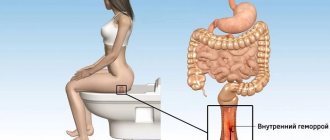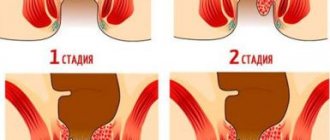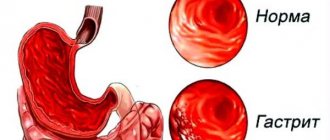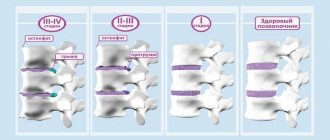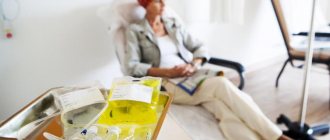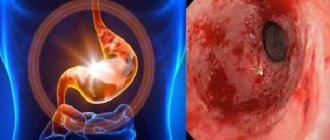Hemorrhoids of the 2nd degree are often diagnosed at the first visit to the proctologist, since this period is characterized by pronounced clinical manifestations. Hemorrhoids are a widespread proctological disease in which pathological dilatation of the vessels of the lower part of the anal canal occurs with the formation of hemorrhoids, which, as the disease progresses, enlarge, periodically become inflamed and bleed.
At this stage, hemorrhoids can be cured with conservative measures
At the second stage of the disease, degenerative processes continue in the muscular-ligamentous apparatus, but the elastic muscle fibers of the rectum are still preserved. With a sharp increase in intra-abdominal pressure (excessive straining during bowel movements, intense physical activity, heavy lifting), internal hemorrhoids may fall out of the anal canal. However, due to the preservation of the elasticity of the fibromuscular frame, they are reduced into the rectum independently. The walls of the mucous membrane of internal hemorrhoids gradually become thinner and are easily injured, which leads to bleeding from the nodes.
Despite the fact that treatment of hemorrhoids at this stage can be carried out at home, a doctor should prescribe it and monitor the progress of therapy.
Hemorrhoids 2nd degree - what to do?
If you suspect hemorrhoids, it is recommended to immediately visit a doctor, undergo examination and begin treatment. At this stage, treatment is usually limited to conservative methods without surgery; hemorrhoids can be eliminated by doing therapy at home. The risk of complications and adverse consequences during this period is relatively low.
Since excessive physical exertion is contraindicated for hemorrhoids, in some cases, if this disease is present, a decision may be made to defer military conscription.
Stages of the disease
Hemorrhoids are a disease associated with thrombosis, inflammation, pathological expansion and tortuosity of the hemorrhoidal veins, which form nodes around the rectum. This disease tends to begin unnoticed .
The gradual development of hemorrhoids in the body is caused by an incorrect lifestyle or lack of hygiene. One stage replaces another over a long period of time.
The main stages of hemorrhoids:
- Stage I – symptoms are almost invisible, the disease passes without pronounced signs.
Accompanied by itching around the anus or a feeling of discomfort during bowel movements. At this stage, it is impossible to detect diseases on your own. Only a doctor can do this. Stage II proceeds more noticeably.
It is characterized by pain during bowel movements. You can read about the features of this stage here. Accompanied by bleeding, itching and burning in the sphincter area. Hemorrhoids may fall out. If you notice any of the above signs, go to the doctor.- III stage of hemorrhoids. It is characterized by prolapse of hemorrhoids during stress on the body, when lifting heavy things, or exercising in the gym.
Prolapse at this stage may not be associated with bowel movements. Enlarged nodes can be detected by touch, but you cannot reduce them yourself. This can lead to complications. Treatment for stage three usually requires surgery. More information about the 3rd stage of the disease is described here. - Stage IV – called acute hemorrhoids.
All symptoms worsen and complications may occur. Even if the knots can be set, they immediately fall out. Do not try to cure hemorrhoids on your own at this stage. Be sure to consult a doctor.
Hemorrhoids can be classified according to several criteria, which we will discuss below.
Depending on the mechanism of occurrence:
- hereditary - passed on from generation to generation;
- acquired - develops independently and is not associated with heredity.
Types of acquired hemorrhoids:
- primary – occurs as an independent disease;
- secondary – occurs as a sign or complication of another disease.
Depending on the place of origin:
- external – occurs under the skin;
- internal – location under the mucosa.
Symptoms of the second stage of hemorrhoids
Hemorrhoids can be acute, but more often they are primarily chronic. Depending on the location of hemorrhoids, they can be internal (the nodes are located in the rectum) and external (the nodes are located outside around the anus), as well as mixed or combined (both external and internal nodes are present at the same time).
The appearance of the external nodes resembles swelling around the anus; in the photo, stage 2 hemorrhoids look like tubercles located in the perianal area, the same color as the surrounding skin. Internal hemorrhoids do not manifest themselves externally before the nodes fall out; the only visible sign of it may be bleeding after bowel movements, usually minor, manifested by scarlet blood stains on toilet paper or an admixture of blood in the stool. Prolapse of hemorrhoids at this stage also usually occurs during bowel movements. Bleeding usually stops on its own, and prolapsed nodes also reset on their own.
The main method of treating second-degree hemorrhoids in the acute stage is drug therapy.
Discomfort in the anal area, itching, burning, and a feeling of constant presence of a foreign body in the rectum appear or intensify. Sometimes the patient complains of a feeling of incomplete bowel movement after defecation.
Since bowel movements are often accompanied by pain, the patient may delay bowel movements, which, in turn, contributes to additional irritation of the rectal mucosa, hardening of the stool and aggravation of symptoms.
Why is this happening
Stage 2 hemorrhoids occur due to the lack of treatment for the disease at the initial stage. Many patients are in no hurry to seek the help of doctors when they discover the first manifestations of pathology. This attitude towards one’s health provokes the transition of hemorrhoids to a chronic stage, accompanied by periodic exacerbations.
Many factors can provoke the progression of the disease:
- poor nutrition;
- sedentary work and sedentary lifestyle;
- pregnancy and childbirth;
- excess weight;
- lack of fluid in the body;
- lifting weights;
- frequent constipation.
Due to the reasons described above, pressure increases in the pelvic area. The walls of vessels overflowing with blood stretch, change shape, and the functioning of the venous valves is disrupted. As a result, hemorrhoids are formed.
Treatment of hemorrhoids stage 2
Despite the fact that treatment of hemorrhoids at this stage can be carried out at home, a doctor should prescribe it and monitor the progress of therapy. Incorrectly selected medications, insufficiently active and consistent treatment, as well as its absence, lead to worsening pathology, an increase in symptoms and an increased risk of complications.
Internal hemorrhoids in the second stage may not manifest themselves as anything other than minor rectal bleeding
The main method of treating grade 2 hemorrhoids in the acute stage is drug therapy. As a rule, local drugs are used, and if necessary, general medications are prescribed. For external hemorrhoids, medicinal ointments, creams, baths, lotions are mainly used; for internal hemorrhoids, rectal suppositories, microenemas, and ointments administered internally using an applicator are used.
Medicines are selected depending on the existing symptoms and disorders. In case of severe pain, local drugs containing an anesthetic and anti-inflammatory agent are prescribed (for example, Proctosan), in case of risk of thrombosis - anticoagulants (Nigepan), in case of bleeding - hemostatic agents (Relief, Natalsid).
A good therapeutic effect is provided by sitz baths with medicinal herbs or a weak solution of potassium permanganate. During exacerbation and bleeding, cool (not cold!) baths are recommended; during the healing stage, warm ones are recommended.
Cucumbers should not be used to treat hemorrhoids, especially straight from the garden - they can easily injure the inflamed mucous membrane and cause infection. It is not recommended to use fresh onions and garlic, which have a pronounced irritant effect.
As a rule, at this stage of the disease, 2-3 weeks of therapy are enough to achieve remission.
If there is no positive effect from drug therapy, it may be necessary to remove hemorrhoids, which is done using minimally invasive methods:
- ligation of hemorrhoidal nodes with latex rings - the node is pinched with a hypoallergenic rubber ring, blood circulation in it is disrupted, it gradually dies, then is removed during defecation;
- cryodestruction - blood circulation in the node stops after treating it with liquid nitrogen;
- sclerotherapy - a sclerosing drug is injected into the hemorrhoidal node, which leads to gluing of the walls of the vessel that forms it, the cessation of blood supply in it and the death of the node;
- photocoagulation - hemorrhoids are exposed to infrared radiation of a certain spectrum, as a result of which the tissues that form them die.
When treating hemorrhoids, it is important to strictly follow all the doctor’s instructions and advice.
Treatment options
You can get rid of stage 2 hemorrhoids by following all the doctor’s recommendations.
You can get rid of stage 2 hemorrhoids by following all the doctor’s recommendations.
Proctologists prescribe medications; some advise at the same time to pay attention to traditional medicine recipes.
Therapy must be comprehensive. For the treatment of the second stage of hemorrhoids, the doctor selects medications taking into account the general well-being of the patient, the severity of the disease, and the number of nodes. The condition of the rectal mucosa is also assessed.
The duration of the course of treatment is determined individually. To improve your well-being, therapy for 10-14 days is sufficient. But pills intended to normalize the condition of the vascular system take longer to take.
Medication
At stage 2 of hemorrhoids, you can get rid of the disease without surgery. If the patient suffers from physical discomfort, then painkillers are prescribed.
If the patient suffers from physical discomfort, then painkillers are prescribed.
When using them, the patient will no longer be afraid of going to the toilet. This will help get rid of constipation of psychogenic origin. Most often prescribed:
- Aurobin ointment;
- Nefluan gel;
- Ultraproct ointment or suppositories;
- Procto-glivenol suppositories.
Medicines with angioprotective and venotonic effects can normalize the condition of the veins and reduce the manifestations of hemorrhoids. They normalize the condition of the vascular walls, improve the tone of the veins and restore microcirculation. Doctors often prescribe Proctosedyl and Hepatrombin.
In addition to local remedies, proctologists recommend Venarus tablets, which prevent vein thrombosis and normalize blood circulation.
In addition to local remedies, proctologists recommend tablets that prevent vein thrombosis and normalize blood circulation:
- Detralex;
- Phlebodia;
- Diosmin;
- Venarus.
With regular use of these drugs, the tone of the venous walls increases, their distensibility and permeability decreases. As a result, the patient stops bleeding.
Minimally invasive
If conservative treatment methods do not help, your doctor may recommend minimally invasive treatment options. Depending on the condition, they may prescribe:
- disarterization;
- ligation with latex rings;
- cryodestruction;
- infrared coagulation;
- sclerosis.
Disarterization takes less than an hour.
After the procedure, blood stops flowing into the problematic hemorrhoidal node. After some time it dies off. Ligation and infrared coagulation work on the same principle. During sclerotherapy, solutions of special drugs (Fibrovein, Trombovar or Aethoxysclerol) are injected into the inflamed node. As a result, the proteins on the inner surface of the node are destroyed and it sticks together.
During cryodestruction, inflamed nodes are treated with liquid nitrogen. Under its influence, they freeze, and necrosis of the inflamed area is observed.
Traditional treatment
You can increase your chances of recovery if you use alternative medicine methods in parallel with conservative treatment. But before using them, it is advisable to consult a proctologist.
You can increase your chances of recovery if you use alternative medicine methods in parallel with conservative treatment.
You can normalize the condition with the help of sitz baths. To prepare them, infusions of medicinal plants (chamomile, calendula, oak bark, onion peel), a weak solution of potassium permanganate or propolis are used.
Various lotions and compresses are considered useful. At home, you can apply a cloth soaked in sea buckthorn oil to the anus. They also make compresses from sage infusion, insert candles from raw potatoes, and honey lotions.
Before defecation, you can insert ice suppositories. With their help, sensitivity is reduced, so the emptying process is easier.
Lifestyle correction and diet therapy
Effective treatment of grade 2 hemorrhoids is impossible without changing the lifestyle that led to the development of the disease. In this case, only a temporary effect from the course of drug therapy is provided, and relapses are inevitable. Patients suffering from hemorrhoids need to adhere to a special diet, compensate for venous congestion during sedentary work with therapeutic exercises (Kegel exercises), proper organization of the workplace, walking, and increased physical activity. At the same time, it is necessary to avoid physical overload, stop lifting heavy objects, and increase stress resistance. You should stop smoking and abuse alcohol, and, if necessary, normalize your body weight.
If there is no positive effect from drug therapy, it may be necessary to remove hemorrhoids, which is performed using minimally invasive methods.
Excessively fatty and spicy foods, baked goods and confectionery products should be excluded from the diet, and any alcohol in the acute stage. It is recommended to eat more vegetables and fruits, flaxseed, seaweed, whole grain cereals, fermented milk products, and bran. The goal of the diet is complete, balanced nutrition that ensures regular bowel activity. A plentiful drinking regime is indicated; you should drink at least 1.5 liters of water per day.
Manifestations and signs of the disease
It is at the second stage of hemorrhoids that doctors discover varicose veins in the patient, which provokes their appearance. If at the first stage it is impossible to say for sure that a person has hemorrhoids, then at the second stage one can already see visual manifestations and feel it when walking .
It is very difficult to independently diagnose internal hemorrhoids of the 2nd degree, since the seals of the nodes are located inside.
Attention: if you detect any discomfort in the anus, you should contact a specialist for help; you should not waste time, because the first and second stages are still amenable to non-surgical treatment, unlike more advanced ones.
What are the main signs of second stage internal hemorrhoids? Signs include:
increased bleeding when going to the toilet “in a big way”;
- increased itching and discomfort in the anal area;
- sensation of a foreign body inside the intestines;
- bowel movements cause pain;
- sometimes hemorrhoids can fall out of the anus when straining;
- constipation;
- Constant discomfort is felt when walking and active physical activity.
How to treat hemorrhoids using traditional methods
Basic therapy can be supplemented with traditional medicine methods. Decoctions and infusions of medicinal herbs are used that have wound-healing, anti-inflammatory, and antiseptic effects. They are added to sitz baths, lotions and compresses are made with them, as well as ice suppositories. At home, you can prepare a medicinal ointment based on medicinal plants, propolis, and natural oils with a wound-healing effect (sea buckthorn, rose hips, apricot).
Traditional methods of treating hemorrhoids can be effective, but they should only be used with the approval of the attending physician
It should be borne in mind that not all folk remedies are effective and safe. For example, cucumbers cannot be used to treat hemorrhoids, especially straight from the garden - they can easily injure the inflamed mucous membrane and cause infection. It is not recommended to use fresh onions and garlic, which have a pronounced irritant effect.
The use of traditional medicine should be carried out under medical supervision in the same way as drug treatment.
The third stage of chronic hemorrhoids
If treatment is chosen incorrectly or started too late, chronic hemorrhoids enter stage 3. The disease at this stage already causes a lot of inconvenience to a person, and treatment can be very difficult. At stage 3, the nodes no longer return on their own to the rectum, but they can be easily retracted by hand. Having discovered that the disease has developed to stage 3, the patient most often consults a doctor.
Symptoms
In stage 3 of the disease, all symptoms intensify. The pain becomes longer and stronger, the patient increasingly experiences severe discomfort when sitting, exercising, and especially when defecating. The nodes can become inflamed, thrombosed and pinched. In this case, the bleeding becomes very severe, the pain is constant, and there is a risk of infection and the development of other dangerous complications.
Treatment
To get rid of chronic hemorrhoids in the 3rd degree, you should definitely consult a doctor, without relying on the advice of friends or your own medical knowledge. The disease, which has developed to stage 3, already imposes significant restrictions on the usual way of life, and the lack of treatment can lead to serious consequences.
In addition to the methods listed above, surgical methods are used to treat grade 3 hemorrhoids. During surgery at stage 3, the nodes are excised with a scalpel. Surgeries are also performed to suturing the vessels feeding the node, after which they die. Surgery always carries a risk of complications, but in some cases it is a necessary measure to treat grade 3 hemorrhoids. Excision is used when the nodes are large and there is a risk of bleeding; this is a rather traumatic method that requires a long rehabilitation period. Dysarterization (suturing of blood vessels) is a more gentle operation, but it is not always applicable.
Traditional medicine methods for the treatment of grade 3 hemorrhoids can only be used after consultation with a doctor. Chronic hemorrhoids, which have developed to stage 3, can already cause dangerous complications, so treatment should be carried out under the supervision of a specialist.
Classification
At stage 1 of the disease, there may be no signs of pathology.
The main symptoms of hemorrhoids are itching, burning, pain in the anus. These signs are inherent in all stages of hemorrhoids. There are four such stages in medicine.
- Stage 1 of hemorrhoids. The disease is diagnosed only through examination and diagnosis. Hemorrhoids swell and enlarge with strong strain or heavy lifting.
- Stage 2 of pathology. Hemorrhoids can come out and move inward on their own after a short period of time. This usually occurs during bowel movements.
- Stage 3 of the disease. Inflamed nodes can come out, but they can only be set with the help of your hands.
- Stage 4 hemorrhoids. The hemorrhoids fall out, and it is no longer possible to set them back.
A proctologist who examines the colon using ultrasound will help you make a diagnosis!


